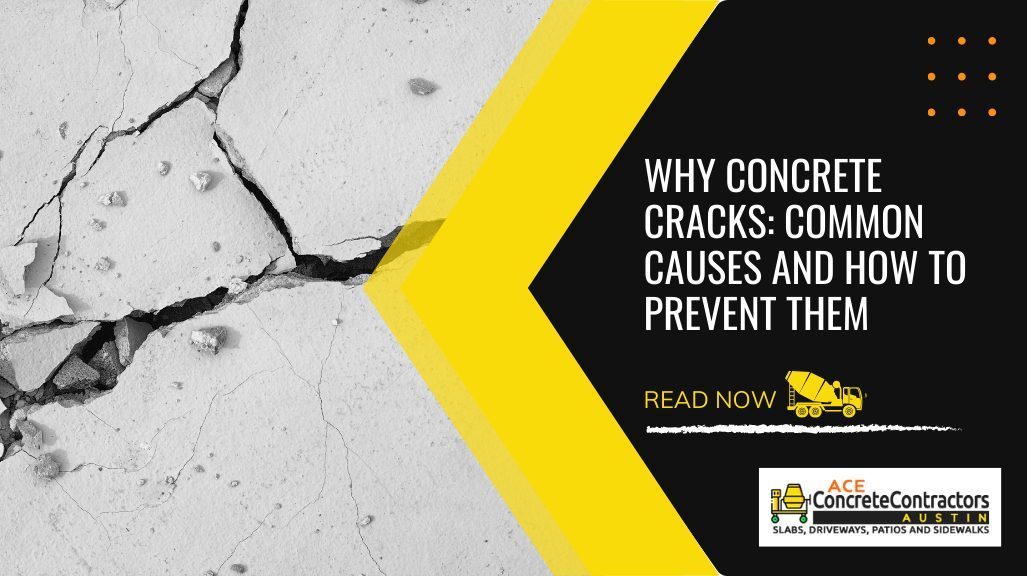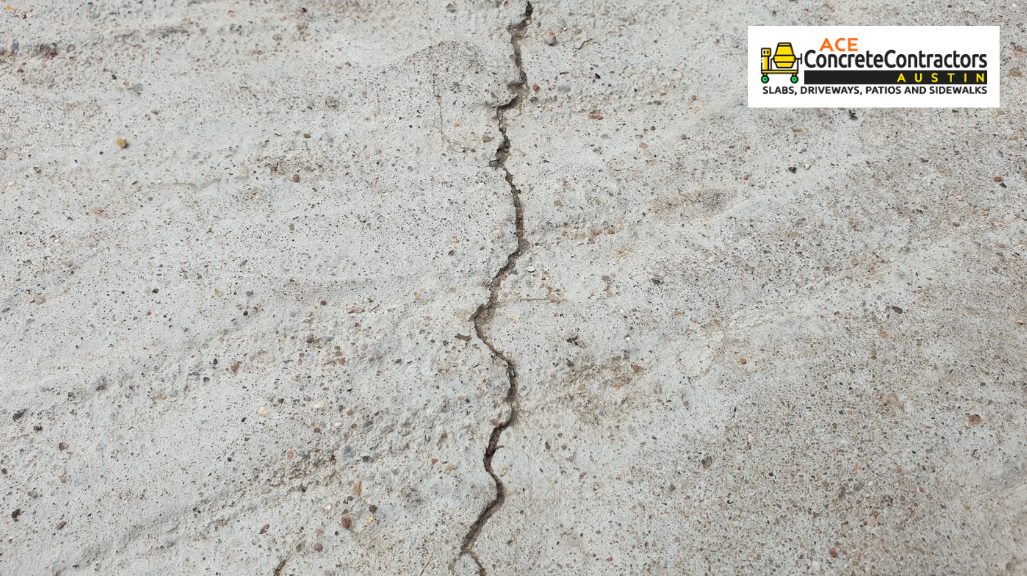
Table of Contents
Concrete is a widely used material known for its durability and versatility. However, even the best-quality concrete can develop a crack under certain conditions. Cracks impact the appearance of concrete surfaces and their structural integrity. As an experienced Austin concrete contractor, Ace Concrete Contractors understands why cracks occur and how to minimize them.
Key Takeaways
- Concrete cracks can result from shrinkage, rapid drying, settlement, temperature changes, and improper concrete mixes.
- The most common types of cracks include hairline cracks, structural cracks, and crazing cracks.
- Preventing cracks involves proper installation techniques, including balanced concrete mixes, control joints, and reinforcement methods.
- Professional installation and timely maintenance, such as sealing and crack repair, can extend the lifespan of your concrete surfaces.
Common Causes of Concrete Cracks

Concrete can experience concrete cracking for various reasons, often influenced by environmental conditions, the concrete mix, or the installation process. Here are the primary causes:
Shrinkage Cracks
- What Happens: As concrete hardens and water evaporates, the material shrinks. This shrinkage can cause small, visible cracks on the surface, known as drying shrinkage cracks.
- Prevention: Use a well-balanced concrete mix with minimal excess water and ensure proper curing to reduce shrinkage. Learn more about proper techniques in our guide on How to Build a Concrete Patio.
Rapid Drying
- What Happens: In hot weather or windy conditions, fresh concrete can lose moisture too quickly, leading to plastic shrinkage cracks or crusting cracks.
- Prevention: Keep concrete moist during the curing process and avoid pouring on hot, windy days.
Settlement Cracks
What Happens: If the ground beneath the concrete slabs shifts or isn’t compacted properly, the concrete can sink and develop cracks.
Prevention: Ensure the ground beneath is compacted and stable before pouring concrete.
Improper Strength Concrete
What Happens: Using the wrong concrete mix or improper strength concrete poured can lead to structural cracks under stress or weight.
Prevention: Use high-quality concrete and incorporate reinforcement like wire mesh or steel bars. Read about Concrete Thickness for Driveways in our blog How Thick Should a Concrete Driveway Be for more insights.
Temperature Changes
- What Happens: Concrete expands in high temperatures and shrinks when temperatures drop, causing early thermal cracks or long cracks over time.
- Prevention: Add expansion joints and control joints to accommodate movement.
Types of Concrete Cracks

Understanding the types of cracks can help you identify the cause and find an appropriate repair solution:
Hairline Cracks
- Cause: Typically due to plastic shrinkage or rapid drying.
- Impact: Usually non-structural but affects the appearance.
Structural Cracks
- Cause: Excessive loads, poor reinforcement, or settlement.
- Impact: Can compromise the structural integrity of the concrete.
Crazing Cracks
- Cause: Over-finishing or rapid drying.
- Impact: Superficial and mostly aesthetic.
Re-entrant Corner Cracks
- Cause: Stress concentration at sharp corners.
- Impact: Can grow over time if not repaired.
- How to Prevent Concrete Cracks
Preventing cracks begins with proper planning, installation, and maintenance. Here’s how you can protect your concrete:
- Proper Concrete Placement
- Ensure concrete is poured evenly and avoid overworking the surface.
- Use control joints and expansion joints to allow for movement without cracking.
- Balanced Concrete Mix
- Avoid using too much water in the concrete mix, as this weakens the final product.
- Incorporate crack-resistant concrete or additives designed to minimize shrinkage.
- Optimal Curing Process
- Keep the concrete moist during curing to slow the drying process.
- Use curing blankets or sprays to retain moisture, especially in hot weather.
- Ground Preparation
- Compact the base layer thoroughly to avoid settlement cracks in new concrete.
- Ensure proper drainage to prevent water accumulation beneath the slab.
For more tips on maintaining your concrete, check out our blog on Concrete Driveway Maintenance.
Repairing Concrete Cracks

If cracks occur, addressing them early can prevent further damage:
- Hairline Cracks
- Use a concrete filler or sealant to cover and smooth the crack.
- Structural Cracks
- Consult a professional Austin concrete contractor to assess and repair deep or wide cracks.
- Reinforce the slab with steel bars or additional layers if needed.
- Preventive Maintenance
- Seal the concrete periodically to protect against moisture and environmental stress.
Frequently Asked Questions (FAQs)
1. What causes cracks in newly poured concrete?
Cracks in newly poured concrete often result from rapid drying, shrinkage, or improper curing.
2. How can I fix cracks in my concrete slab?
Hairline cracks can be repaired with fillers or sealants, while structural cracks require professional evaluation and repair to address the factors causing the concrete to crack.
3. Are all concrete cracks a sign of structural issues?
No, some cracks, like shrinkage or hairline cracks, are superficial and don’t impact the structural strength of the concrete.
4. Can proper curing prevent most concrete cracks?
Yes, proper curing helps retain moisture during drying, reducing the risk of shrinkage and cracking.
5. How do expansion joints help prevent cracks?
Expansion joints absorb movement caused by temperature changes, preventing cracks from forming as the concrete expands or contracts.
If your concrete is cracked or you are planning a new project, contact Ace Concrete Contractors today. Our team provides expert advice and high-quality solutions to keep your concrete surfaces in shape. Let’s build something that lasts!
